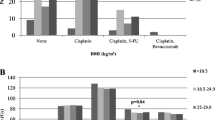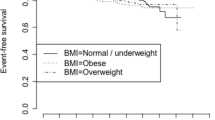Abstract
Objective
To assess the impact of body mass index (BMI) on radiotherapy toxicities in endometrial cancer patients.
Methods
This was a retrospective cohort study of women diagnosed with endometrial cancer between January 2006 and December 2014 at the Royal Cornwall Hospital Trust. Women who received radiotherapy as part of their treatment, including external beam radiotherapy (EBRT) and/or vaginal brachytherapy were included. Radiation-related toxicities were graded according to the Radiation Therapy Oncology Group (RTOG) guidelines. Toxicity outcomes were compared across BMI groups—non-obese (BMI <30 kg/m2) and obese (BMI ≥30 kg/m2)—according to radiotherapy treatment received (EBRT, brachytherapy or a combination).
Results
Of a total of 159 women who received radiotherapy, 110 were eligible for inclusion in the study. Sixty-three women had a BMI <30 kg/m2 and 47 women were obese. Obese women had poorer Eastern Cooperative Oncology Group performance status (P = 0.021) and more comorbidities (P < 0.001) compared to the non-obese group. Total (any) toxicity rates were 60.3, 72.7 and 52.0% for EBRT and brachytherapy (N = 63), single-mode EBRT (N = 22) and brachytherapy (N = 25), respectively. BMI was not associated with the incidence of acute and late radiation toxicities in the different radiotherapy groups, and there were no differences in individual complications between the BMI groups.
Conclusion
When comparing obese to non-obese women, obesity does not negatively impact the incidence of radiation toxicities in endometrial cancer. However, toxicities remain an important challenge as they are common and negatively influence the quality of life (QoL) of survivors. Future studies need to further explore the role of BMI and possible interventions to improve toxicities and QoL.


Similar content being viewed by others
References
Cancer Research UK (2014) Uterine cancer incidence statistics. Cancer Research UK, London, UK
Colombo N, Preti E, Landoni F et al (2013) Endometrial cancer: ESMO clinical practice guidelines for diagnosis, treatment and follow-up. Ann Oncol 24(6):vi33–vi38 (Epub 2013/10/23)
Nout RA, Smit VT, Putter H et al (2010) Vaginal brachytherapy versus pelvic external beam radiotherapy for patients with endometrial cancer of high-intermediate risk (PORTEC-2): an open-label, non-inferiority, randomised trial. Lancet 375(9717):816–823 (Epub 2010/03/09)
Creutzberg CL, van Putten WL, Koper PC et al (2000) Surgery and postoperative radiotherapy versus surgery alone for patients with stage-1 endometrial carcinoma: multicentre randomised trial. PORTEC Study Group. Post operative radiation therapy in endometrial carcinoma. Lancet 355(9213):1404–1411 (Epub 2000/05/03)
Keys HM, Roberts JA, Brunetto VL et al (2004) A phase III trial of surgery with or without adjunctive external pelvic radiation therapy in intermediate risk endometrial adenocarcinoma: a Gynecologic Oncology Group study. Gynecol Oncol 92(3):744–751 (Epub 2004/02/27)
Blake P, Swart AM, Astec En Study Group et al (2009) Adjuvant external beam radiotherapy in the treatment of endometrial cancer (MRC ASTEC and NCIC CTG EN.5 randomised trials): pooled trial results, systematic review, and meta-analysis. Lancet 373(9658):137–146 (Epub 2008/12/17)
Dandapani SV, Zhang Y, Jennelle R et al (2015) Radiation-associated toxicities in obese women with endometrial cancer: more than just BMI? Scientific World J 2015:483208 (Epub 2015/07/07)
Sorbe BG, Horvath G, Andersson H et al (2012) External pelvic and vaginal irradiation versus vaginal irradiation alone as postoperative therapy in medium-risk endometrial carcinoma: a prospective, randomized study–quality-of-life analysis. Int J Gynecol Cancer 22(7):1281–1288 (Epub 2012/08/07)
Koh YV, Tang JI, Choo BA et al (2014) Adjuvant radiotherapy for endometrial cancer–a comparative review of radiotherapy technique with acute toxicity. Eur J Gynaecol Oncol 35(2):128–133 (Epub 2014/04/30)
Smits A, Lopes A, Das N et al (2014) The impact of BMI on quality of life in obese endometrial cancer survivors: does size matter? Gynecol Oncol 132(1):137–141 (Epub 2013/11/23)
Arnold M, Pandeya N, Byrnes G et al (2015) Global burden of cancer attributable to high body-mass index in 2012: a population-based study. Lancet Oncol 16(1):36–46 (Epub 2014/12/04)
Alexander CI, Liston WA (2006) Operating on the obese woman–A review. BJOG 113(10):1167–1172 (Epub 2006/09/16)
Bouwman F, Smits A, Lopes A et al (2015) The impact of BMI on surgical complications and outcomes in endometrial cancer surgery-An institutional study and systematic review of the literature. Gynecol Oncol 139(2):369–376 (Epub 2015/09/27)
Cox JD, Stetz J, Pajak TF (1995) Toxicity criteria of the Radiation Therapy Oncology Group (RTOG) and the European Organization for Research and Treatment of Cancer (EORTC). Int J Radiat Oncol Biol Phys 31(5):1341–1346 (Epub 1995/03/30)
IBM Corp (2012) IBM SPSS statistics for windows, version 21.0. IBM Corp, Armonk (Released)
Horowitz NS, Wright AA (2015) Impact of obesity on chemotherapy management and outcomes in women with gynecologic malignancies. Gynecol Oncol 138(1):201–206 (Epub 2015/04/15)
Martra F, Kunos C, Gibbons H et al (2008) Adjuvant treatment and survival in obese women with endometrial cancer: an international collaborative study. Am J Obstet Gynecol 198(1):89 e1–89 e8 (Epub 2008/01/02)
Asiri MA, Tunio MA, Alhaddab AR et al (2012) Impact of body mass index on treatment outcomes of adjuvant radiation therapy in saudi females with endometrial carcinoma. World J Surg Med Radiat Oncol 1:119–129
von Gruenigen VE, Tian C, Frasure H et al (2006) Treatment effects, disease recurrence, and survival in obese women with early endometrial carcinoma: a Gynecologic Oncology Group study. Cancer 107(12):2786–2791 (Epub 2006/11/11)
Moszyńska-Zielińska M, Chałubińska-Fendler J, Gottwald L et al (2014) Does obesity hinder radiotherapy in endometrial cancer patients? The implementation of new techniques in adjuvant radiotherapy − focus on obese patients. Prz Menopauzalny 18(2):96–100 (Epub 2014 May 21)
Lin LL, Hertan L, Rengan R et al (2012) Effect of body mass index on magnitude of setup errors in patients treated with adjuvant radiotherapy for endometrial cancer with daily image guidance. Int J Radiat Oncol Biol Phys 83(2):670–675 (Epub 2012/01/03)
Choi M, Fuller CD, Wang SJ et al (2009) Effect of body mass index on shifts in ultrasound-based image-guided intensity-modulated radiation therapy for abdominal malignancies. Radiother Oncol 91(1):114–119 (Epub 2008/09/23)
Bray TS, Kaczynski A, Albuquerque K et al (2013) Role of image guided radiation therapy in obese patients with gynecologic malignancies. Pract Radiat Oncol 3(4):249–255 (Epub 2014/03/29)
Kim H, Beriwal S, Huq MS et al (2012) Evaluation of set-up uncertainties with daily kilovoltage image guidance in external beam radiation therapy for gynaecological cancers. Clin Oncol 24(2):e39–e45 (Epub 2011/09/29)
Wong JR, Gao Z, Merrick S et al (2009) Potential for higher treatment failure in obese patients: correlation of elevated body mass index and increased daily prostate deviations from the radiation beam isocenters in an analysis of 1465 computed tomographic images. Int J Radiat Oncol Biol Phys 75(1):49–55 (Epub 2008/12/17)
Arem H, Irwin ML (2013) Obesity and endometrial cancer survival: a systematic review. Int J Obes 37(5):634–639 (Epub 2012/06/20)
Veldeman L, Madani I, Hulstaert F et al (2008) Evidence behind use of intensity-modulated radiotherapy: a systematic review of comparative clinical studies. Lancet Oncol 9(4):367–375 (Epub 2008/04/01)
Mundt AJ, Lujan AE, Rotmensch J et al (2002) Intensity-modulated whole pelvic radiotherapy in women with gynecologic malignancies. Int J Radiat Oncol Biol Phys 52(5):1330–1337 (Epub 2002/04/17)
Mazeron R, Petit C, Rivin E et al (2015) 45 or 50 Gy, which is the optimal radiotherapy pelvic dose in locally advanced cervical cancer in the perspective of reaching magnetic resonance image-guided adaptive brachytherapy planning aims. Clin Oncol (R Coll Radiol) 28(3):171–177 (Epub 2015/11/09)
Whelan B, Kumar S, Dowling J et al (2015) Utilising pseudo-CT data for dose calculation and plan optimization in adaptive radiotherapy. Australas Phys Eng Sci Med 38(4):561–568
Acknowledgements
The authors are very grateful to the radiotherapy planning team at the Royal Cornwall Hospital Trust including Elaine Buck, Marina Cousins, Claire Cartledge and Tom Durnall for their contribution to the data collection. In addition, we would like to thank Frederique Bouwman for her contribution to data collection.
Author information
Authors and Affiliations
Corresponding author
Ethics declarations
Conflict of interest statement
(1) I declare that the contents of this paper have not been published or considered for publication elsewhere. (2) All authors made a substantial contribution to conception and design, and/or acquisition of data and/or analysis and interpretation of data; participated in drafting the article or revising it critically for important intellectual content; and gave final approval of the version to be submitted and any revised version to be published. (3) There is no financial support or relationship that may pose conflict of interest.
About this article
Cite this article
Smits, A., McGrane, J., Lopes, A. et al. Radiation-related toxicities and outcomes in endometrial cancer: are obese women at a disadvantage?. Int J Clin Oncol 22, 945–953 (2017). https://doi.org/10.1007/s10147-017-1147-5
Received:
Accepted:
Published:
Issue Date:
DOI: https://doi.org/10.1007/s10147-017-1147-5




